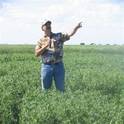
Novel management practices are needed to increase dryland soil organic matter and crop yields that have been declining due to long-term conventional tillage with spring wheat (Triticum aestivum L.)-fallow system in the northern Great Plains, USA. The effects of tillage, crop rotation, and cultural practice were evaluated on dryland crop biomass (stems + leaves) yield, surface residue, and soil organic C (SOC) and total N (STN) at the 0–20 cm depth in a Williams loam (fine-loamy, mixed, superactive, frigid, Typic Argiustolls) from 2004 to 2007 in eastern Montana, USA. Treatments were two tillage practices [no-tillage (NT) and conventional tillage (CT)], four crop rotations [continuous spring wheat (CW), spring wheat-pea (Pisum sativum L.) (W-P), spring wheat-barley (Hordeum vulgaris L.) hay-pea (W-B-P), and spring wheat-barley hay-corn (Zea mays L.)-pea (W-B-C-P)], and two cultural practices [regular (conventional seed rates and plant spacing, conventional planting date, broadcast N fertilization, and reduced stubble height) and ecological (variable seed rates and plant spacing, delayed planting, banded N fertilization, and increased stubble height)]. Crop biomass and N content were 4 to 44% greater in W-B-C-P than in CW in 2004 and 2005 and greater in ecological than in regular cultural practice in CT. Soil surface residue amount and C and N contents were greater in NT than in CT, greater in CW, W-P, and W-B-C-P than in W-B-P, and greater in 2006 and 2007 than in 2004 and 2005. The SOC and STN concentrations at 0–5 cm were 4 to 6% greater in CW than in W-P or W-B-P in NT and CT from 2005 and 2007. In 2007, SOC content at 10–20 cm was greater in W-P and W-B-P than in W-B-C-P in CT but STN was greater in W-B-P and W-B-C-P than in CW in NT. From 2004 to 2007, SOC and STN concentrations varied at 0–5 cm but increased at 5–20 cm. Diversified crop rotation and delayed planting with higher seed rates and banded N fertilization increased the amount of crop biomass returned to the soil and surface residue C and N. Although no-tillage increased surface residue C and N, continuous nonlegume cropping increased soil C and N levels at the surface layer compared with other crop rotations. Continued return of crop residue from 2004 to 2007 may increase soil C and N levels but long-term studies are needed to better evaluate the effect of management practices on soil C and N levels under dryland cropping systems in the northern Great Plains.
- carbon sequestration,
- crop rotation,
- cultural practice,
- nitrogen storage,
- plant biomass,
- surface residue,
- tillage
Available at: http://works.bepress.com/andrew_lenssen/72/
